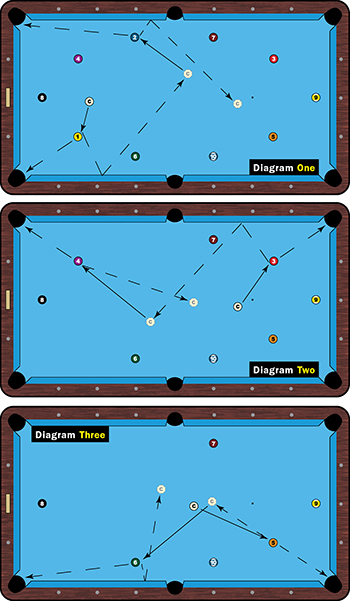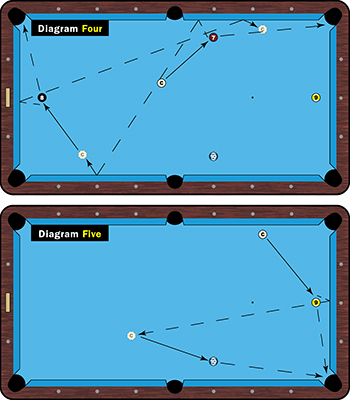Your patterns will take shape with this creative drill.
Hereís another great drill that is easy to set up and a perfect pattern drill. I like the shape of this drill and its purpose. Itís a great rotation pattern drill that anyone from league player to pro can benefit from.
As you might expect by looking at the setup, this drill puts a premium on staying in the middle of the table. Thatís always a great tool when the balls are spread out. You can get through this mainly with one-rail position, although some shots will be simple soft draws and no rail.
The rules are simple enough: Start with ball in hand. Run the balls in rotation. Youíre not allowed to bump another ball and you donít need to use a rail. (For pro level, a minimum of one rail is required on each shot.)
As always, Iím surprised by how often a player will begin with ball in hand and choose the wrong placement. Place the cue ball in the wrong spot and the run can end in a hurry.

For instance, I see amateurs take ball in hand here and place the cue ball for a straight in shot on the 1, or a very slight angle. Draw straight back from the 1 and you can quickly get in trouble. Come up short or go long and get stuck behind the 7 and the run is over.
I prefer to set this up at a slightly steeper angle and strike it soft with a lot of left English on the cue ball. Let the cue ball do all the work. This is an easier and safer option.
From the 2 to the 3, just use a soft draw and a little right, which will make the pocket play bigger. Donít quit on this shot and the cue ball will come nicely out just passed the center of the table.
A little punch with a half-tip of left off the 3 will get the cue ball back to the center of the table. And if you land straight on the 4 ball or 5 ball, thatís fine. From the 4 to the 5 and 5 to 6, you can simply draw straight back to the center of the table. Life is so much easier when you keep the cue ball away from the rails. Being able to get your hand on the table gives you so many more options and freedom to execute.
Position in the center of the table will give you a nice angle on the 6. I like punching this shot with a little left, but your personal preference will dictate what approach you take here.
The 7 ball is the key shot because there are several options. You can draw with left English if youíre really confident in your stroke. You can come up short here. Even worse, if you donít catch it right or the table is a little slick, you could scratch in the bottom left corner pocket. I prefer using one rail and landing close to the middle diamond between the side and corner pockets.
For the 8 ball, just play high ball with no English and let the cue ball float up table. If anything, use just a touch of right to guarantee not scratching in the top corner if you overhit the cue ball.

Again, just high ball on the 9, but you need to stay still on this shot. The nerves start to catch up to you near the end of the rack. As always, using just a touch of right will make the pocket play bigger in the event the 9 catches the short rail first. That little spin transferred from the cue ball to the 9 will assure that it slides in nicely.
The game-winning 10 will be easy but I always encourage players to avoid rolling this ball in. You donít want to risk it skidding, so use a soft draw or punch shot to eliminate that possibility.
This is a nice drill for all levels. It will get you into stroke and give you a good feel for the table. If you can complete this regularly, youíre well on your way to good pattern play. And if you donít make it through, keep trying to beat your personal best.





